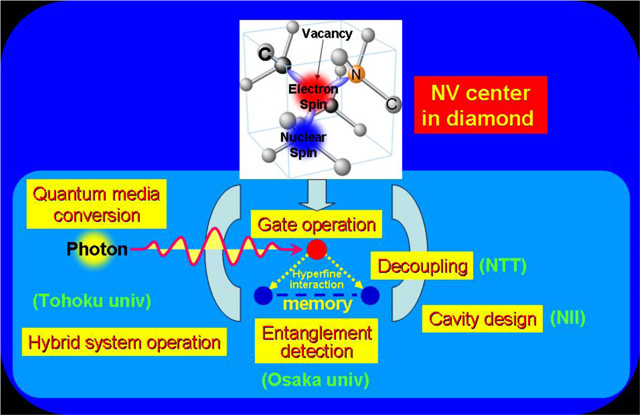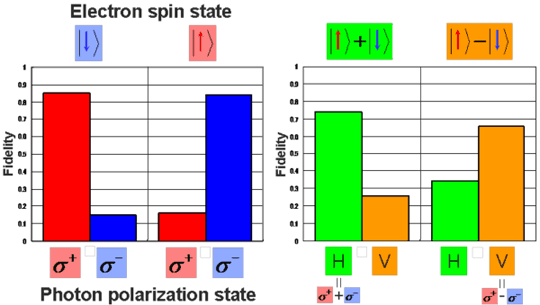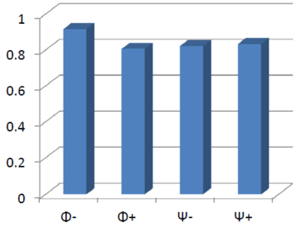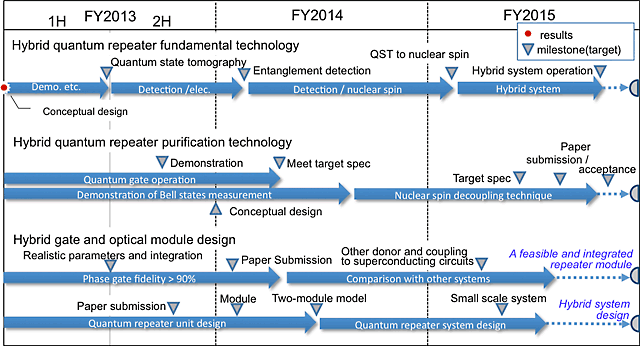
Subject B : Entanglement purification between distant nodes
158B-T01Quantum repeater based on diamond NV centers
Tohoku University (Hideo Kosaka)
Osaka University
Nippon Telegraph and Telephone Corporation
National Institute of Informatics
To make a practical quantum repeater, a long-lived quantum memory is highly desirable device at the nodes. Our target is to make an interface between a photon as a transmission qubit and a nuclear spin as a memory qubit intermediated by an electron spin as a gate qubit.
Toward this purpose, we have several candidates such as semiconductor quantum dots, NV centers in diamond, and rare-earth impurities in non-linear crystal. Among those candidates this project focuses on NV centers in diamond which provide longest memory time together with reasonable optical activity.
The project consists of four groups – Tohoku univ., Osaka univ., NTT, and NII. Each of them contributes different aspects as summarized below.
- Subtheme 1: Quantum media conversion from a photon into a nuclear spin (Tohoku univ.)
- The main task of Tohoku university group is to transfer the quantum state of a photon into a nuclear spin via an adjacent electron spin at an NV
- Subtheme 2: Enhancing application platform (Osaka univ.)
- Osaka university group try to detect the entangled state stored in multiple nuclear spins.
- Subtheme 3-1: Next generation quantum key distribution system technology (NTT)
- NTT group theoretically supports this entanglement detection by solving the decoupling problem between an electron spin and nuclear spins during the state transfer and gate operation.
- Subtheme 3-2: Long-term operational testing (NII)
- NII group theoretically supports the cavity design which is ideal for a practical quantum repeater which consists of hybrid systems.

For quantum entanglement purification between remote nodes, gate operation and entanglement detection between nuclear spins intermediated by an electron spin are needed besides the quantum media conversion. Furthermore, we have to solve the issue of fidelity degradation upon the system operation when we combine the quantum media conversion, gate operation, and entanglement detection.
Interim results for Team 158B-T01
| Task title | Outcome | Date | Note |
|---|---|---|---|
| 1: Hybrid quantum repeater fundamental technology | a) Experimental demonstration of entanglement detection between a photon and an electron spin | Aug. 2013 | MRS2013 |
| b) Preliminary experiments for quantum state tomography of a nuclear spin via photon absorption | Aug. 2013 | MRS2013 | |
| 2: Hybrid quantum repeater purification technology | a) Demonstration of fast quantum gate operation of electron spin (< 10 ns) | Sep. 2013 | |
| b) Demonstration of detection of entangled state stored in multiple nuclear spins. (F > 75%) | Mar. 2013 | SEST2013 | |
| 3: Hybrid gate and optical module design | 1a) Protocol for gate operation between ele. and nuc. spin with F>90% within ∼ 4 ms | Apr. 2012 | |
| 1b) Optimized protocol with phase gate fidelity > 99% within ∼ 4 ms | Apr. 2013 | ||
| 2a) One-side cavity design with a single NV | Mar. 2012 | QCMC2012 | |
| 2b) Numerical analysis on N-V-C system | Oct. 2013 | CLEO-PR2013 MRS2013 |
Task 1: Entanglement detection between a photon and an electron spin has been demonstrated by utilizing the inherent spin-orbit entanglement of an electron via the degenerate Λ-V system in an NV center in diamond (Fig. 1). We also showed the possibility of entanglement detection between a photon and a nuclear spin by utilizing the hyperfine interaction. These demonstrations enable quantum state tomography of an electron and a nuclear spin via photon absorption heralded by the phonon-sideband emission, and supplies building blocks for a long-distance quantum repeater.
Task 2: Detection of entangled states (= four Bell states, Φ-,Φ+,Ψ-,Ψ+) stored in multiple nuclear spins has been demonstrated (Fig. 2). The four Bell states were generated and detected in NV center which couples with three 13C nuclear spins. The fidelities of the detection of the four Bell states are shown in figure. The smallest one was larger than 75%.
Task 3-1: Our task was to design a simple and efficient protocol that would allow for the transfer of the state of the electron spin to the nuclear spin. We have designed set of operations that allow this to be achieved without the need for complicated composite pulse sequences. These operations include both the electron and nuclear spin rotations, as well as an entangling gate between them. These are experimentally realizable gates with current technology of sufficiently high fidelities that they can be used to build graph states for quantum information processing tasks
Task 3-2: NVC system has been analyzed in details. We numerically solved the three body problem, and determined the gate fidelity for single qubit operations for each component. This analysis is a basis for optical control for optical modules for single diamond NV center. More than 99% fidelity can be achieved by square pulse driving, which can be sufficient for quantum repeater protocol. The direction of further improvement needs to be discussed jointly with the quantum repeater system development.

Fig. 1Phase dependence of detection probability as a function of photon and electron-spin polarizations

Fig. 2Detection probability of entangled statesstored in multiple nuclear spins
Targets for Team 158B-T01
| Task title | Work/Milestone | Due Date | Note |
|---|---|---|---|
| 1: Hybrid quantum repeater fundamental technology | a) High fidelity entanglement detection between a photon and an electron | Apr. 2014 | Target fidelity >90% |
| b) Entanglement detection between a photon and a nuclear spin | Aug. 2014 | Target fidelity >80% | |
| c) Teleportation-based quantum media conversion from a photon to an nuclear spin | Apr. 2015 | Target fidelity >80% | |
| 2: Hybrid quantum repeater purification technology | a) Fast quantum gate operation of electron spin | Aug. 2014 | 105 gate operations within T2 |
| b) Demonstration of complete entangled states (Bell states) measurement in multiple nuclear spins | Dec. 2015 | Target fidelity > 90 % | |
| c) Practical decoupling technique for quantum memory of nuclear spin | Dec. 2015 | T2 > 1 ms | |
| 3: Hybrid gate and optical module design | 1a) Realistic parameters with phase gate fidelity > 90% | Apr. 2014 | Operation time ∼1µs |
| 1b) Comparison with other donor systems | Apr. 2015 | ErYSO : Bandwidth ∼10MHz | |
| 2a) Quantum repeater unit design | Oct. 2014 | Scalable design | |
| 2b) Quantum repeater system design | Oct. 2015 | Scalable design |

Chart 1Schedule for Team 158B-T01